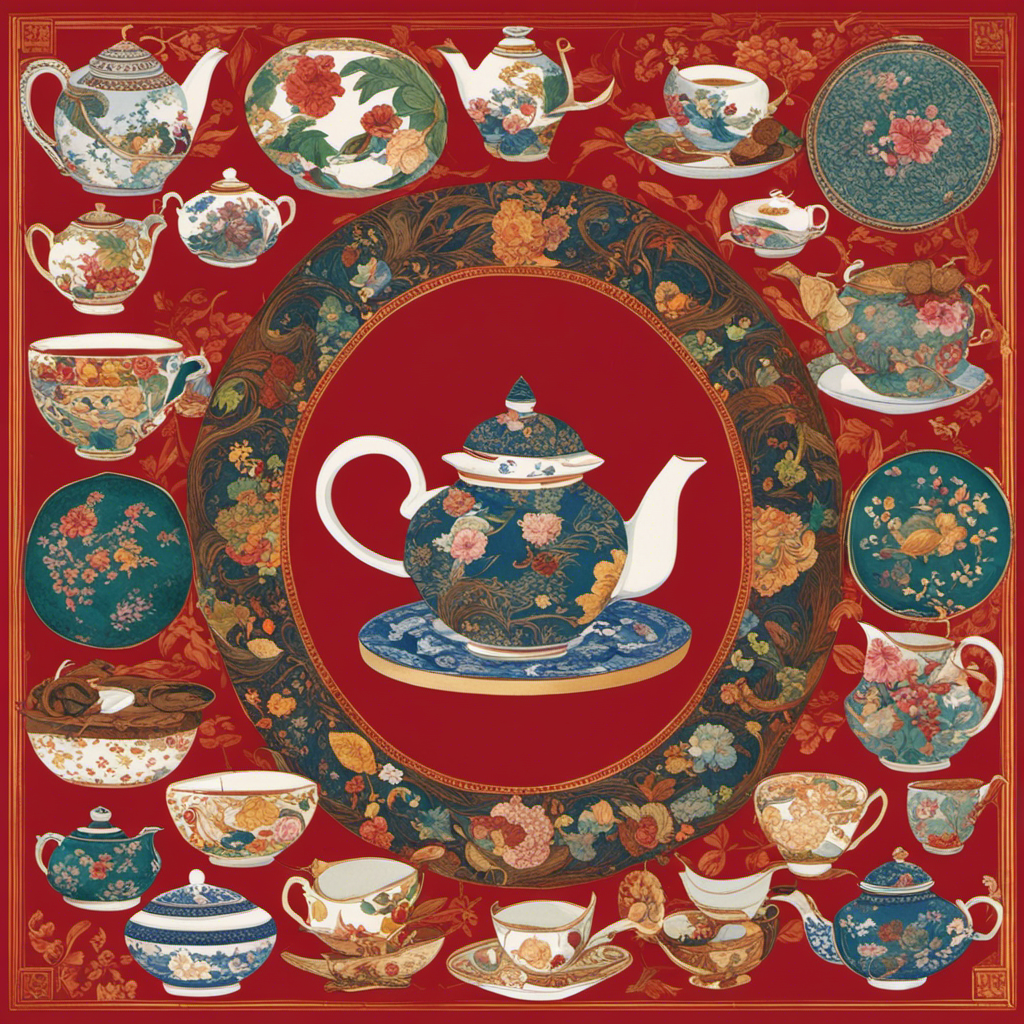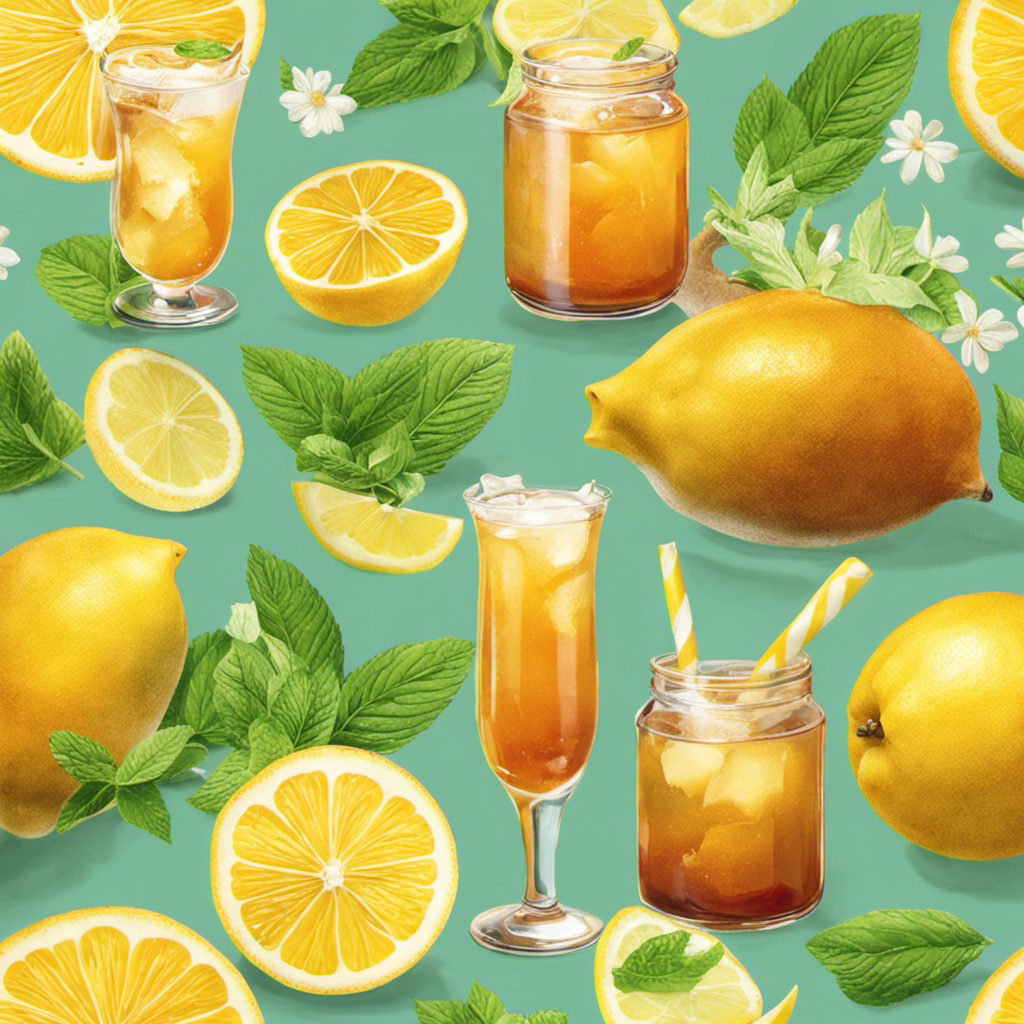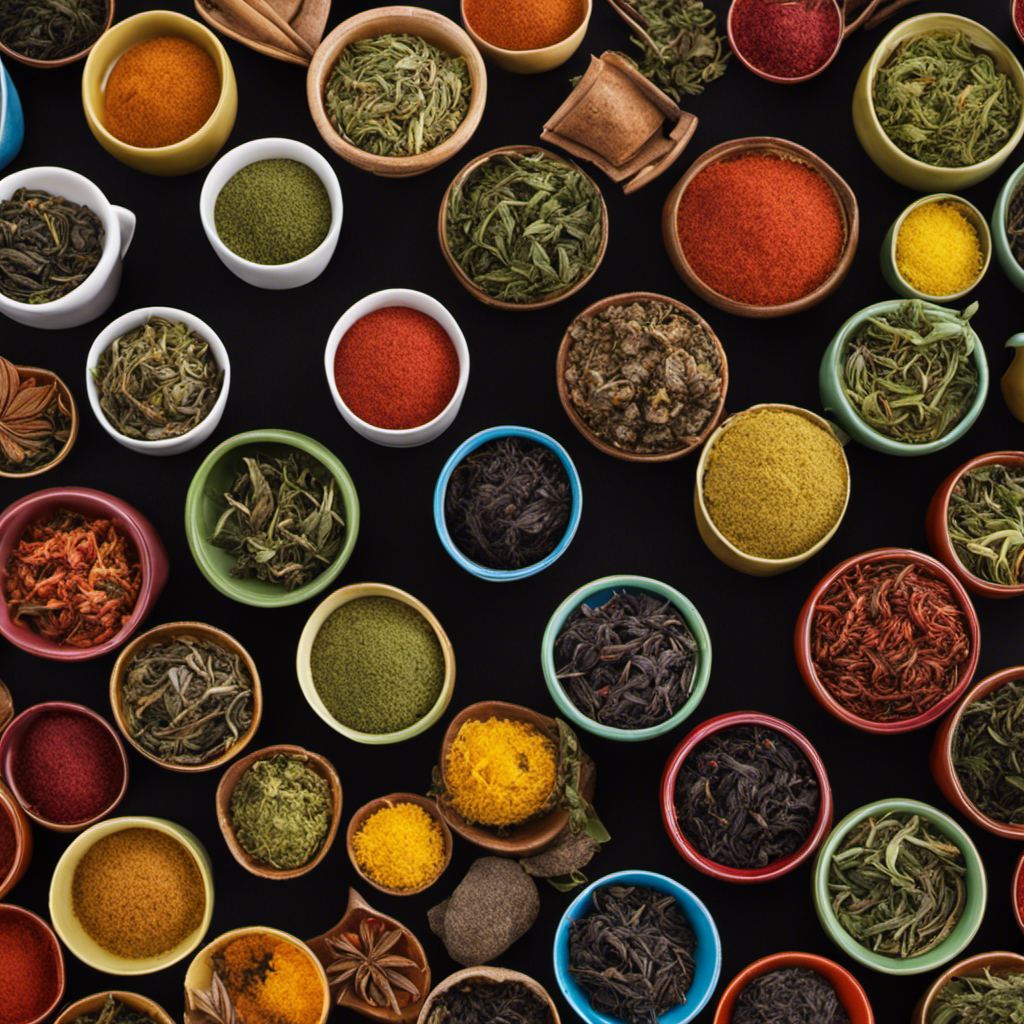Coffee Alternatives And Tea
How Tea Consumption Varies Across Different Cultures Around the World

Were you aware that tea holds the position of being the world’s second-most popular drink, only trailing behind water in consumption?
It’s fascinating to explore how tea consumption varies across different cultures. From the elaborate tea ceremonies of Asia to the vibrant tea markets of Africa, each culture has its unique rituals and traditions.
In this article, we will delve into the diverse ways tea is enjoyed around the world, highlighting the cultural, historical, and social aspects that shape this beloved beverage.
Key Takeaways
- Tea consumption varies across different cultures around the world, with each culture having its own unique traditions and customs associated with tea.
- Asian cultures, such as China and Japan, have a long history of tea consumption and place importance on tea ceremonies and rituals.
- Middle Eastern and African cultures view tea as a symbol of hospitality and use it as a way to bring people together.
- European and South American cultures also have their own distinct tea traditions, with black tea being popular in Europe and herbal teas playing a significant role in South America.
The Origins of Tea Culture
I’ve always been fascinated by the origins of tea culture and how it has developed differently in various parts of the world. The practice of tea ceremonies has its roots in ancient China, dating back to the 9th century. Tea was considered a medicinal beverage with spiritual and healing properties. Over time, the tea ceremony became an integral part of Chinese culture, symbolizing harmony, respect, and tranquility.
In Japan, tea culture was introduced by Buddhist monks in the 12th century. The Japanese tea ceremony, known as Chanoyu, emphasizes simplicity and mindfulness. It’s a ritualistic practice that involves the preparation and serving of matcha, a powdered green tea. The tea ceremony holds great historical significance in Japan, representing hospitality, discipline, and Zen philosophy.
India, on the other hand, has a long history of tea consumption that can be traced back to the 3rd century BCE. Tea in India is deeply embedded in its social fabric and is enjoyed in various forms, such as masala chai and Assam tea. The British colonization of India greatly influenced the tea culture, leading to the establishment of tea plantations and the widespread consumption of black tea.
The historical significance of tea in different cultures is evident in the rituals, customs, and symbolism associated with its consumption. From China to Japan to India, tea has played a vital role in shaping cultural practices and traditions. It has brought people together, fostered social connections, and provided moments of respite and reflection.
The origins of tea culture reflect the rich diversity of human history and the ways in which this humble beverage has become an integral part of our lives.
Tea in Asian Cultures
Growing up in Asia, it’s fascinating to witness the diverse ways in which tea is integrated into various cultural practices and traditions. Tea cultivation methods and tea varieties differ across different Asian countries, resulting in a rich tapestry of tea cultures.
In China, for example, the traditional method of tea cultivation involves hand-picking the leaves and carefully processing them through different stages of withering, rolling, oxidizing, and drying. This method produces a wide range of tea varieties, including green tea, black tea, oolong tea, and pu-erh tea.
In Japan, on the other hand, tea cultivation follows a more meticulous approach, with shaded growing conditions and steam processing that result in the famous matcha tea.
The different tea varieties in Asia also reflect the unique cultural practices and preferences of each country. For instance, in China, tea is often brewed in a gaiwan or small clay teapot, and the focus is on the flavor and aroma of the tea. In Japan, tea ceremonies are a prominent part of the culture, with a deep emphasis on the ritualistic preparation and presentation of matcha tea.
As we delve into the next section on tea ceremonies and rituals, it becomes evident that the cultivation methods and tea varieties play a crucial role in shaping the cultural practices surrounding tea.
Tea Ceremonies and Rituals
Attending tea ceremonies and observing the meticulous rituals involved has deepened my appreciation for the cultural significance attached to the preparation and presentation of tea. These ceremonies aren’t simply about enjoying a hot beverage; they’re a reflection of the values, traditions, and customs of the cultures in which they originated.
In Asian cultures, tea ceremonies hold a prominent place. The Japanese tea ceremony, known as Chanoyu, is a highly formalized affair that emphasizes harmony, respect, and tranquility. The host meticulously prepares and serves tea to guests, following a set of prescribed movements and gestures. The entire process is a choreographed dance, where every movement and action has a symbolic meaning. The tea itself is carefully selected, brewed, and presented in exquisite teaware, enhancing the sensory experience.
Comparatively, tea ceremonies in other Asian cultures, such as China and Korea, also carry immense cultural significance. Each ceremony has its own unique rituals and practices, reflecting the distinct traditions and values of the respective societies. However, they all share a common purpose: to create a sense of unity, mindfulness, and appreciation for the beauty of tea.
Transitioning to the subsequent section about tea in Middle Eastern cultures, it’s fascinating to explore how the cultural significance of tea manifests in these regions.
Tea in Middle Eastern Cultures
Experiencing the rich flavors and aromatic blends of Middle Eastern tea has broadened my understanding of the diverse cultural practices surrounding its consumption. Middle Eastern tea traditions and customs are deeply rooted in history and play a significant role in daily life. Unlike the elaborate tea ceremonies found in some Asian cultures, Middle Eastern tea customs are more relaxed and informal, yet no less meaningful.
Tea is a symbol of hospitality and is often served to guests as a sign of welcome. It’s commonly prepared using loose tea leaves and boiled water, then sweetened with sugar or flavored with fragrant herbs like mint or cardamom. The tea is poured from a height to create a frothy top and is traditionally served in small glass cups. This method of preparation and presentation adds to the sensory experience and enhances the enjoyment of the tea.
What sets Middle Eastern tea apart is the social aspect it brings. Tea is often served alongside conversations, storytelling, and gatherings with family and friends. It’s a catalyst for connection and community, fostering a sense of togetherness. The act of sharing tea is seen as a way to strengthen relationships and build trust.
In comparison to other tea-drinking cultures, Middle Eastern tea customs emphasize the importance of hospitality and the art of conversation. While some cultures focus on the preparation and presentation of tea, Middle Eastern tea traditions highlight the social aspect and the role it plays in bringing people together. The flavors and aromas of Middle Eastern tea are just the beginning; it’s the customs and traditions that truly make the experience unique.
Tea in African Cultures
Sitting around a fire with members of the Maasai tribe, I learned that tea is an integral part of their daily lives and is often shared as a gesture of friendship and respect. African tea traditions are diverse and reflect the rich cultural heritage of the continent. Tea ceremonies in Africa vary from tribe to tribe, each with its unique customs and practices.
In many African cultures, tea isn’t just a beverage, but a symbol of hospitality. It’s often served to guests as a way of showing respect and welcoming them into the community. The Maasai, for example, have a tradition of serving tea to visitors as a sign of friendship and goodwill.
Tea ceremonies in Africa also serve as a means of connecting with ancestors and the spiritual world. In some tribes, like the Zulu, tea is used in rituals and ceremonies to honor the spirits and seek their guidance. It’s believed that tea has the power to bring people closer to their ancestors and create a sense of unity within the community.
Comparatively, African tea traditions differ from those in other parts of the world. While in some cultures tea is consumed for its calming effects, in Africa it’s seen as a social activity that brings people together. The act of sharing tea promotes bonding and fosters a sense of belonging within the community.
Tea in European Cultures
Growing up in Europe, I’ve always been surrounded by the rich tea culture that’s deeply ingrained in our daily lives. Tea has played a significant role in European history, shaping traditions and influencing social interactions. When it comes to popular tea flavors in Europe, there’s a wide range of options to choose from.
-
Black Tea: Black tea is the most commonly consumed type of tea in Europe. Its robust flavor and bold aroma make it a favorite among tea enthusiasts. Countries like England and Ireland have a strong affinity for black tea, often enjoyed with a splash of milk.
-
Herbal Tea: Herbal teas have gained popularity in Europe due to their various health benefits. Chamomile, peppermint, and nettle are some of the most commonly consumed herbal teas. They’re known for their soothing properties and are often enjoyed in the evening as a way to relax and unwind.
-
Fruit Infusions: Fruit infusions, such as berry teas and citrus blends, are favored for their vibrant flavors and refreshing qualities. These teas are particularly popular during the summer months and are often enjoyed both hot and iced.
European tea culture is diverse and dynamic, with each country adding its own unique touch to the centuries-old tradition. Whether it’s a cup of strong black tea, a calming herbal infusion, or a fruity blend, tea continues to captivate the taste buds of Europeans and remains an integral part of our cultural heritage.
Tea in South American Cultures
When it comes to South American tea traditions, herbal teas play a significant role in the culture and daily life of many countries in the region. These herbal teas, also known as tisanes, are made by steeping various plants, flowers, and herbs in hot water, resulting in a fragrant and flavorful beverage.
One of the most popular South American herbal teas is yerba mate, which is widely consumed in countries like Argentina, Uruguay, and Paraguay. Yerba mate is made from the leaves of the Ilex paraguariensis plant and has a slightly bitter taste. It’s often shared among friends and family, with a communal gourd and metal straw called a bombilla.
Another herbal tea that’s commonly enjoyed in South America is chamomile tea. Known for its calming properties, chamomile tea is made from the dried flowers of the chamomile plant. It’s often sipped before bedtime to promote relaxation and a good night’s sleep.
In comparison to European tea traditions, South American herbal teas offer a unique and diverse range of flavors and health benefits. Whether it’s the invigorating taste of yerba mate or the soothing properties of chamomile, these teas are an integral part of South American cultures, providing comfort and nourishment to its people.
The Role of Tea in Social Gatherings
When it comes to social gatherings, tea plays a significant role in bringing people together. It serves as a ritual that’s steeped in tradition and symbolizes hospitality.
Whether it’s a formal tea party or a casual get-together, the act of sharing a cup of tea creates a sense of connection and fosters a warm and inviting atmosphere.
Tea as a Ritual
As a tea enthusiast, I find it fascinating how tea isn’t just a beverage, but a cherished ritual in many cultures around the world. Tea has become an integral part of people’s lives, serving as both a daily routine and a form of self-care.
In China, tea is prepared with precision and grace, with elaborate ceremonies that highlight the importance of mindfulness and tranquility.
In Japan, the tea ceremony, or ‘chanoyu,’ is a highly revered practice that emphasizes harmony, respect, and purity.
In India, tea is a symbol of hospitality and is often shared among friends and family as a way to strengthen bonds and foster connection.
Across these cultures, tea is seen as more than just a hot beverage. It’s a moment of pause, a time to reflect and rejuvenate. Whether it’s the artistry of the tea ceremony or the warmth of sharing a cup with loved ones, tea rituals offer a sense of calm and self-nourishment in a busy world.
Tea and Hospitality
I love how sharing a cup of tea with friends and family creates a warm and welcoming atmosphere. Tea holds a special place in many cultural traditions and social customs around the world. It is fascinating to see how different cultures have their unique ways of preparing and serving tea, each with its own set of rituals and etiquette. To illustrate this, let’s compare the tea traditions of three countries:
| Country | Tea Type | Preparation | Serving Style |
|---|---|---|---|
| China | Green | Careful | Gongfu |
| England | Black | Steeped | Afternoon |
| Japan | Matcha | Whisked | Ceremonial |
In China, tea preparation is meticulous, with a focus on the quality of the leaves and the art of brewing. England, on the other hand, is famous for its afternoon tea, where black tea is steeped and served with finger sandwiches and scones. In Japan, the preparation of matcha tea is a ceremonial practice, involving a special whisk and a meditative approach. These cultural traditions and social customs surrounding tea highlight the significance it holds in bringing people together and fostering a sense of hospitality.
Traditional Tea Recipes and Preparation Methods
Growing up in India, I always enjoyed the traditional tea recipes and preparation methods that have been passed down through generations. Tea brewing in India is a ritualistic process that involves the use of unique ingredients and techniques.
Here are some fascinating aspects of traditional tea brewing methods in India:
-
Ingredients: Indian tea is typically made with black tea leaves, milk, water, and sugar. However, the flavors can vary depending on the region and personal preferences. For example, in Assam, tea is often brewed with ginger and cardamom for a spicier flavor, while in Kashmir, saffron is added for a luxurious touch.
-
Preparation: The tea leaves are boiled in water until they release their flavors and aromas. Then, milk and sugar are added to create a creamy and sweet blend. The tea is simmered for a few minutes to allow the flavors to meld together perfectly.
-
Serving: Indian tea is traditionally served in small clay cups called ‘kulhads’ to enhance the flavor and aroma. It’s often accompanied by snacks like biscuits or fried snacks for a delightful tea-time experience.
In comparison to other countries, traditional Indian tea brewing methods offer a unique and rich flavor profile. The use of spices and the combination of milk and sugar create a harmonious blend that’s both comforting and invigorating.
Tea as a Symbol of Hospitality
Hospitality is symbolized by serving tea in many cultures, including India. Tea holds a special place as a cultural symbol and a form of communication in various societies around the world. It is not just a beverage, but a way to welcome guests and foster connections.
In India, tea is considered a symbol of warmth and hospitality. It is customary to offer tea to guests as soon as they arrive, as a gesture of welcome and respect. The act of serving tea creates a sense of intimacy and allows people to connect on a deeper level. It provides an opportunity for conversations to flow and relationships to be formed.
Tea as a Symbol of Hospitality:
| Culture | Tea Rituals |
|---|---|
| India | Serving tea to guests as a gesture of welcome and respect |
| Morocco | Serving mint tea as a symbol of hospitality and friendship |
| Japan | Conducting tea ceremonies to promote harmony and tranquility |
| England | Afternoon tea as a social ritual and a way to entertain |
| China | Offering tea as a sign of respect and gratitude |
Across different cultures, tea serves as a form of communication. It is a way to express care, affection, and respect for others. The act of serving tea is often accompanied by rituals and traditions, which further enhance its symbolic value. Whether it’s the elaborate tea ceremonies in Japan or the simple act of offering a cup of tea in India, tea brings people together and fosters meaningful connections. It is a powerful tool that transcends language barriers and allows individuals to communicate on a deeper level.
Tea in Religion and Spirituality
The role of tea in religious and spiritual practices is diverse and significant, with various traditions incorporating tea as a means of connection and reflection. In many cultures around the world, tea is used as a tool for meditation, helping individuals to achieve a state of calm and clarity. The act of preparing and drinking tea becomes a form of mindfulness, as each step is performed with intention and focus.
Tea and spiritual awakening often go hand in hand, with the brewing process symbolizing the journey towards enlightenment. As the tea leaves steep in hot water, they release their essence, representing the release of one’s inner self. This transformation mirrors the spiritual awakening experienced by individuals on their path towards self-discovery and enlightenment.
In some traditions, tea ceremonies are performed as a way to connect with the divine. These ceremonies are highly ritualized and can be seen as a form of worship. The act of serving and receiving tea becomes a sacred exchange, fostering a connection between individuals and the spiritual realm.
Overall, tea plays a significant role in religious and spiritual practices, serving as a tool for meditation, a symbol of spiritual awakening, and a means of connecting with the divine. Its ability to calm the mind and foster introspection makes it a powerful tool for those seeking spiritual growth and enlightenment.
Modern Trends in Tea Consumption
I’ve noticed a shift in the way people drink tea nowadays, with a greater emphasis on unique flavors and innovative brewing methods. Modern tea trends have elevated tea consumption to a whole new level, where it isn’t just a beverage but an experience.
Gone are the days of plain black tea or simple green tea. Today, tea lovers are exploring a wide range of flavors such as fruity infusions, floral blends, and even savory options like matcha. The availability of different tea varieties and the accessibility to global tea markets have contributed to this diversification of taste preferences.
In addition to unique flavors, there’s also a growing focus on the wellness aspect of tea. People are becoming more aware of the health benefits associated with different types of tea and are incorporating them into their daily routines. From herbal teas that aid in digestion to teas rich in antioxidants that promote overall well-being, the connection between tea and wellness is becoming increasingly evident.
This shift in modern tea trends reflects a societal movement towards a more holistic approach to health and well-being. As people become more conscious of what they consume, they’re turning to tea not only for its delicious taste but also for its potential health benefits. With this newfound appreciation for tea and its wellness properties, it isn’t surprising that the popularity of tea continues to grow.
In the next section, we’ll explore the specific health benefits associated with different types of tea.
Tea and Health Benefits
As a tea enthusiast, I’ve personally experienced the positive impact that different types of tea can have on my overall well-being. Tea isn’t only a delicious beverage, but it also offers numerous health benefits.
Here are three ways that tea can improve your health:
-
Weight Loss:
-
Green tea: Known for its metabolism-boosting properties, green tea can aid in weight loss by increasing fat oxidation and improving insulin sensitivity.
-
Oolong tea: This traditional Chinese tea has been shown to enhance weight loss by increasing energy expenditure and fat oxidation.
-
Pu-erh tea: With its ability to reduce cholesterol and promote fat burning, pu-erh tea is often used as a weight loss aid in many Asian cultures.
-
Mental Health:
-
Chamomile tea: This herbal tea is renowned for its calming effects and is often used as a natural remedy for anxiety and insomnia.
-
Peppermint tea: Known for its refreshing aroma, peppermint tea can help relieve stress and improve focus and concentration.
-
Lavender tea: Made from the fragrant lavender flowers, this tea is often used for its soothing and relaxing properties, helping to reduce anxiety and promote better sleep.
In conclusion, incorporating different types of tea into your daily routine can have a positive impact on both your physical and mental well-being. Whether you’re looking to shed a few pounds or alleviate stress, there’s a tea out there that can help you achieve your health goals.
Tea in Literature and Art
When it comes to tea, its influence extends beyond the teacup and into the realms of literature and art. Tea has been a recurring theme in literature, symbolizing various meanings and serving as a metaphor for life itself.
In literature, tea often represents tranquility and a moment of respite. It’s depicted as a soothing beverage that brings people together, fostering conversation and connection. Take, for instance, the classic novel ‘Alice’s Adventures in Wonderland’ by Lewis Carroll, where the Mad Hatter’s tea party serves as a metaphor for the absurdity and chaos of life.
Art, too, has embraced the allure of tea. From delicate still-life paintings of teacups and saucers to intricate Japanese tea ceremonies captured on canvas, tea has been a subject of artistic exploration. These artworks often depict the ritualistic nature of tea-drinking, highlighting the elegance and grace associated with the act.
Comparatively, tea in literature and art share a common thread. Both mediums utilize tea to convey deeper meanings and emotions. Whether it’s illustrating the calmness amidst chaos or capturing the beauty of a ceremonial ritual, tea in literature and art serves as a powerful symbol that transcends cultural boundaries.
The Future of Tea Culture
In the future, I look forward to exploring how tea culture will continue to evolve and adapt to the changing tastes and preferences of individuals. The future of tea ceremonies will be shaped by the impact of technology on tea culture. Here are three ways in which I believe tea culture will transform in the coming years:
-
Enhanced Tea Experiences: Technology will enable tea enthusiasts to have immersive and personalized tea experiences. Virtual reality could transport us to tea gardens around the world, allowing us to witness the entire tea-making process firsthand. Smart devices could analyze our preferences and suggest new tea blends based on our taste profiles, making tea consumption a more tailored and enjoyable experience.
-
Sustainable Practices: As environmental consciousness grows, tea culture will adapt to incorporate sustainable practices. Technology can play a vital role in this transition. For instance, blockchain technology could ensure transparency and traceability in the tea supply chain, promoting fair trade and environmentally friendly practices.
-
Online Tea Communities: The internet has already facilitated the growth of online communities centered around tea. In the future, these communities will continue to thrive, providing a platform for tea lovers to connect, share knowledge, and learn from one another. Virtual tea ceremonies could become more common, allowing people from different parts of the world to come together and experience the beauty of tea culture.
Overall, the future of tea culture holds exciting possibilities. Technology will undoubtedly play a significant role in shaping the way we consume and appreciate tea, making it a more personalized and sustainable experience.
Frequently Asked Questions
What Are the Different Types of Tea Available in Different Cultures?
When it comes to tea varieties and tea ceremonies, different cultures around the world have their own unique traditions. From the delicate and floral green teas of Japan’s tea ceremonies to the strong and robust black teas of Britain’s afternoon tea, the types of tea available vary greatly.
Each culture has its own preferences and customs when it comes to tea consumption, making it a fascinating topic to explore and compare.
How Does the Process of Harvesting and Processing Tea Differ Across Cultures?
Harvesting and processing techniques for tea vary greatly across different cultures. Each culture has its own unique methods and traditions associated with tea production. These techniques are shaped by factors such as climate, soil conditions, and cultural practices.
The cultural significance of tea consumption also influences how it’s harvested and processed. For example, in Japan, tea leaves are hand-picked and carefully processed to preserve their delicate flavors. This meticulous approach is due to the high regard for tea in Japanese culture and the emphasis on the art of tea preparation.
In contrast, in India, tea is often harvested using machines. The large-scale production and demand for tea in India require efficient harvesting methods. The harvested leaves then undergo a different processing method to create bold and robust flavors. This method is influenced by the preference for strong and flavorful tea in Indian culture.
Are There Any Specific Tea-Related Superstitions or Beliefs in Different Cultures?
Tea related superstitions and beliefs have a significant impact on tea consumption.
Superstitions can vary across cultures, influencing how tea is prepared, served, and consumed.
For example, in some cultures, it’s believed that certain teas have healing properties or bring good luck.
Others may have rituals or traditions surrounding the serving of tea.
These beliefs add depth and cultural richness to the experience of tea drinking, making it more than just a beverage.
How Does the Presentation and Serving of Tea Vary Across Different Cultures?
When it comes to tea, the presentation and serving methods vary across different cultures. Tea ceremonies and tea etiquette play a significant role in these variations.
Different cultures have their own unique ways of preparing and presenting tea. For example, in Japan, the tea ceremony is a formal and ritualistic event that involves specific steps and gestures.
In contrast, in Chinese culture, tea is often served in small cups without milk or sugar.
These differences highlight the diverse cultural practices surrounding tea consumption.
What Are Some Unique Tea Customs or Traditions Found in Lesser-Known Cultures?
When it comes to tea, there’s a world of customs and traditions waiting to be discovered. Lesser-known cultures have their own unique tea ceremonies and rituals that are truly fascinating.
From the elaborate tea rituals of the Moroccan Maghrebi culture to the tranquil tea ceremonies of the Japanese Ryokan, each culture brings its own flair and meaning to the art of tea.
Exploring these lesser-known tea rituals unveils a world of cultural diversity and richness.
Conclusion
In conclusion, the diverse cultures around the world have developed unique tea traditions that reflect their history, values, and social customs.
From the elaborate tea ceremonies in Asia to the vibrant tea markets in Africa, tea has become an integral part of people’s lives.
As we sip our cup of tea, we not only enjoy its health benefits but also immerse ourselves in the rich tapestry of literature and art that has been inspired by this ancient beverage.
The future of tea culture is bright, as more people discover the joy and beauty of this timeless drink.
Justin is a seasoned author, coffee and tea enthusiast, and an essential member of the Cappuccino Oracle team. With a keen appreciation for the complexities of coffee, coffee alternatives, and tea, Justin has dedicated his professional career to exploring these realms and sharing his insights with readers worldwide.
Justin’s immersion in the world of coffee, coffee alternatives, and tea began at a young age, kindling a passion that extended beyond mere consumption. This love for these beverages led him to combine his talent for writing with his devotion to coffee and tea, bringing him to Cappuccino Oracle as a dedicated author.
Turmeric Tea
What Does Kombucha Tea Do to Your Body

Curious about the effects of kombucha tea on your body? Allow me to shed some light on the topic.
This ancient fermented drink has gained popularity in recent years for its potential health benefits. From improving digestion and gut health to boosting the immune system and aiding in detoxification, kombucha tea offers a range of positive effects.
However, it’s important to be aware of potential side effects and take necessary precautions.
So, let’s dive in and explore the wonders of kombucha tea!
Key Takeaways
- Kombucha tea promotes healthy digestion and gut health by aiding in nutrient absorption, breaking down food, and restoring beneficial bacteria in the gut.
- It supports the immune system through the presence of beneficial bacteria, probiotics, antioxidants, polyphenols, and vitamins and minerals.
- Kombucha tea has detoxification properties that help neutralize free radicals, eliminate toxins, improve liver function, and promote a healthy gut microbiome.
- It is important to be aware of potential side effects and precautions, such as possible allergic reactions, contamination risks, and starting with small amounts to minimize side effects. It is also advisable to consult with a healthcare provider if you have a weakened immune system or underlying health conditions.
Health Benefits of Kombucha Tea
You’ll be pleased to know that drinking kombucha tea can provide you with numerous health benefits.
One of the most notable benefits is its potential for weight loss. Kombucha tea is low in calories and can help to suppress appetite, making it a great addition to a weight loss regimen. Additionally, kombucha tea contains acetic acid, which has been found to increase metabolism and fat burning. It also aids in digestion, promoting a healthy gut, which is essential for maintaining a healthy weight.
Another benefit of kombucha tea is its impact on skin health. The tea is rich in antioxidants, which help to protect the skin from damage caused by free radicals. It also contains probiotics, which can improve skin conditions such as acne and eczema.
Effect on Digestion and Gut Health
The fermentation in kombucha can promote healthier digestion and gut health. Kombucha is rich in digestive enzymes, which help break down food and enhance nutrient absorption. Additionally, it contains probiotic bacteria that can restore the balance of beneficial bacteria in the gut, supporting a healthy digestive system.
Kombucha can alleviate digestive issues such as bloating and gas, providing relief and improving overall comfort. The probiotics in kombucha can strengthen the intestinal barrier, reducing the risk of leaky gut syndrome and enhancing gut health. By promoting the growth of beneficial bacteria in the gut, kombucha can support a healthy microbiome and improve digestion.
These effects on digestion and gut health are crucial for maintaining overall wellness. Furthermore, the impact of kombucha on the immune system is worth exploring.
Impact on Immune System
Boosting your immune system is essential for maintaining overall health and well-being. One way to strengthen your defenses is by incorporating kombucha tea into your diet. Kombucha is a fermented tea that contains beneficial bacteria and antioxidants, which can support your immune system. Studies have shown that the probiotics found in kombucha can help improve gut health and enhance the body’s ability to fight off infections. Additionally, the antioxidants in kombucha can help reduce inflammation and oxidative stress, further supporting immune function. To emphasize the benefits of kombucha for immunity, here is a table showcasing some key components and their effects:
| Component | Effect on Immune System |
|---|---|
| Probiotics | Enhances immune response |
| Antioxidants | Reduces inflammation |
| Polyphenols | Boosts immune function |
| Vitamins and Minerals | Supports overall health |
Incorporating kombucha tea into your daily routine can be a simple and delicious way to boost your immunity and strengthen your body’s defenses.
Detoxification Properties of Kombucha Tea
Incorporating kombucha into your routine can help detoxify and cleanse your system. This fermented tea contains beneficial compounds that support the detoxification process and promote liver health. Here are three reasons why kombucha is a great addition to your detox regimen:
-
Kombucha contains antioxidants that help neutralize harmful free radicals in the body, reducing oxidative stress and supporting the natural detoxification process.
-
The organic acids present in kombucha, such as acetic acid and glucuronic acid, aid in the elimination of toxins and improve liver function.
-
Kombucha is rich in probiotics, which promote a healthy gut microbiome. A balanced gut microbiome is crucial for optimal detoxification and overall well-being.
By incorporating kombucha into your routine, you can enhance your body’s natural detoxification process and promote liver health.
However, it is important to be aware of potential side effects and take necessary precautions.
Potential Side Effects and Precautions
While kombucha can offer numerous health benefits, it’s important to be aware of potential side effects and take necessary precautions.
Although considered generally safe for most people, there are potential risks associated with consuming kombucha tea. One of the main concerns is the possibility of allergic reactions. Some individuals may be sensitive to certain components in kombucha, such as yeast or bacteria, and may experience symptoms like hives, itching, or difficulty breathing.
It’s also worth noting that homemade kombucha may carry a higher risk of contamination, leading to adverse effects. To minimize the chances of experiencing side effects, it is recommended to start with small amounts of kombucha and gradually increase the intake.
Additionally, individuals with weakened immune systems or underlying health conditions should consult with their healthcare provider before consuming kombucha.
Frequently Asked Questions
Can Kombucha Tea Help With Weight Loss?
I’ve found that kombucha tea can be helpful for weight loss. It can boost metabolism and aid in appetite control. However, it’s important to note that it should be consumed as part of a balanced diet and exercise routine.
How Often Should I Drink Kombucha Tea to Experience Its Health Benefits?
To experience the health benefits of kombucha tea, I drink it regularly. It’s important to find a balance and not overdo it. I’ve found that drinking it a few times a week works well for me.
Can Kombucha Tea Cure or Prevent Cancer?
Can kombucha tea really cure or prevent cancer? While there are no scientific studies to support this claim, kombucha tea has been known to support the immune system and improve digestive health.
Is It Safe to Consume Kombucha Tea During Pregnancy?
During pregnancy, it is important to consider the potential risks and side effects of consuming kombucha tea. It is best to consult with a healthcare professional to determine if it is safe for breastfeeding mothers.
Does Kombucha Tea Have Any Effect on Mental Health or Anxiety?
Kombucha tea can have a positive effect on mood and help reduce stress. It contains B vitamins and probiotics, which support a healthy gut-brain connection. Regular consumption may contribute to improved mental well-being.
Conclusion
In conclusion, it’s safe to say that indulging in a glass of kombucha tea every now and then can work wonders for your body.
From promoting healthy digestion and gut health to boosting your immune system, this fizzy elixir is a true gem.
Not to mention its detoxifying properties, which gently cleanse your body from within.
However, as with anything, it’s important to exercise caution and moderation.
So go ahead and enjoy the delightful benefits of kombucha tea, but remember to sip responsibly.
Noah, the Editor-in-Chief at Cappuccino Oracle, plays a pivotal role in shaping the voice and vision of our renowned platform. With an unwavering passion for coffee, coffee alternatives, and tea, Noah leads Cappuccino Oracle towards new horizons in the realm of coffee journalism.
Beyond his professional responsibilities, Noah serves as a mentor and guiding force for his team. His dedication to journalistic excellence and genuine love for coffee, coffee alternatives, and tea continue to inspire and motivate the Cappuccino Oracle family. In the ever-evolving world of these beverages, Noah’s leadership ensures that our platform remains at the forefront, delivering enlightening and enjoyable content to our readers worldwide.
Turmeric Tea
Where Did Kombucha Scoby Tea Originate

I have always been fascinated by the origins of kombucha scoby tea. As I explored its history, I unearthed a captivating journey that has unfolded over centuries and across continents.
This ancient drink, known for its probiotic properties and unique flavor, has a rich cultural significance and a deep-rooted tradition.
In this article, we will explore the historical significance, cultural roots, and traditional brewing methods of kombucha scoby tea.
So, let’s dive in and uncover the truth behind where this beloved beverage truly originated.
Key Takeaways
- Kombucha scoby tea originated in China over 2,000 years ago during the Qin Dynasty.
- It was consumed for its medicinal properties and believed to have detoxifying effects and digestive benefits.
- Kombucha has been part of different cultures’ traditions for thousands of years.
- Brewing and consuming kombucha has brought communities together and fostered a sense of connection.
The Ancient Origins of Kombucha Scoby Tea
You might be curious to know that the ancient origins of kombucha scoby tea can be traced back to China over 2,000 years ago. Kombucha, also known as ‘the tea of immortality,’ has a rich history and a reputation for its health benefits.
The origins of kombucha can be attributed to the Qin Dynasty, where it was consumed for its medicinal properties. Traditional Chinese medicine believed that kombucha had detoxifying effects and could improve digestion and overall well-being.
The unique fermentation process used to create kombucha involves a symbiotic culture of bacteria and yeast (SCOBY), which creates a fizzy, tangy, and slightly sweet beverage. This ancient elixir has been passed down through generations, transcending time and cultures, and continues to be enjoyed today for its various health benefits.
Now, let’s delve into the historical significance of kombucha scoby tea.
Historical Significance of Kombucha Scoby Tea
The historical significance of this fermented drink can be traced back to its ancient origins. Kombucha scoby tea has a rich history that spans centuries and cultures. Here are three reasons why this drink holds such importance:
-
Tradition: Kombucha has been consumed for thousands of years, with its origins believed to be in China or Russia. It has been passed down through generations, becoming a beloved part of different cultures’ traditions.
-
Health Benefits: Kombucha is known for its potential health benefits. It is rich in probiotics, which can promote gut health and digestion. It also contains antioxidants, which can help protect against oxidative stress and inflammation.
-
Community: Kombucha brewing has brought communities together for centuries. It has been shared among friends and family, fostering a sense of connection and camaraderie.
Understanding the historical origins and health benefits of kombucha scoby tea allows us to appreciate its significance in our lives today.
Cultural Roots of Kombucha Scoby Tea
Believed to have its roots in China or Russia, kombucha scoby tea has been a part of different cultures’ traditions for thousands of years. This ancient beverage has been influenced by various cultural practices, each adding their unique twist to the brewing process.
In China, kombucha is known as ‘chájūn’ and is believed to have been consumed for its health benefits. In Russia, it is called ‘chaynyy grib’ and is often associated with folklore and traditional medicine. These cultural influences have shaped the way kombucha is brewed and consumed today.
Kombucha scoby tea is celebrated for its numerous health benefits, including probiotics, antioxidants, and detoxification properties. It is believed to support digestion, boost the immune system, and improve overall gut health.
With its rich cultural heritage and health-promoting properties, kombucha scoby tea continues to be enjoyed by people worldwide.
Kombucha Scoby Tea’s Journey Across Continents
Traveling across continents, kombucha scoby tea found its way into different cultures and was embraced for its unique flavors and health benefits. People from all walks of life have come to appreciate the numerous benefits that this fermented tea offers. Here are three reasons why kombucha scoby tea has gained such popularity today:
Improved Digestion: Kombucha scoby tea contains probiotics, which promote a healthy gut by improving digestion and aiding in nutrient absorption. This can lead to reduced bloating, increased energy levels, and a strengthened immune system.
Detoxification: The tea is rich in antioxidants that help eliminate toxins from the body, supporting liver health and boosting overall detoxification processes.
Mental Well-being: Kombucha scoby tea is known to have a positive impact on mental health. Its B vitamins and amino acids can help reduce stress, improve mood, and enhance cognitive function.
Given its wide range of health benefits, it’s no wonder that kombucha scoby tea has become a popular beverage choice today. Transitioning into the next section, let’s explore the traditional brewing methods of this remarkable tea.
Traditional Brewing Methods of Kombucha Scoby Tea
To brew kombucha scoby tea traditionally, you’ll need a few basic ingredients like black or green tea, sugar, and a scoby. The traditional methods of brewing kombucha scoby tea involve a fermentation process that has been passed down for generations.
First, I start by boiling water and steeping the tea leaves for about 10 minutes. Then, I add sugar to the hot tea and stir until it dissolves completely. After the tea has cooled to room temperature, I transfer it to a glass jar and place the scoby on top. The scoby acts as a culture that will feed on the sugar and convert the tea into a tangy and fizzy beverage.
I cover the jar with a cloth and let it sit undisturbed for about a week, allowing the fermentation process to take place. During this time, the scoby consumes the sugar, producing carbon dioxide and various acids that give kombucha its unique taste.
Once the desired flavor is achieved, I strain the tea and store it in the refrigerator for a refreshing and healthy drink.
Frequently Asked Questions
What Are the Health Benefits of Drinking Kombucha Scoby Tea?
Drinking kombucha scoby tea has numerous health benefits. It boosts digestion, strengthens the immune system, detoxifies the body, and improves gut health. The brewing process involves fermenting sweet tea with a scoby, resulting in a probiotic-rich beverage.
What Are the Different Flavors of Kombucha Scoby Tea Available?
There are many flavored variations of kombucha scoby tea available, each with its own unique taste. Brewing techniques can vary, but the common goal is to ferment the tea with a symbiotic culture of bacteria and yeast (SCOBY) to create a tangy and fizzy beverage.
How Long Does It Take to Brew Kombucha Scoby Tea?
Brewing time for kombucha scoby tea varies, but it usually takes around 7-14 days. Temperature control is important during fermentation to ensure proper growth of the scoby and the desired flavor profile.
Can Kombucha Scoby Tea Be Made at Home?
Sure, you can make kombucha scoby tea at home. It’s easy and has many benefits. You’ll need a scoby, tea, sugar, and patience. Homemade kombucha scoby tea is delicious, probiotic-rich, and a great way to support gut health.
Is Kombucha Scoby Tea Suitable for People With Dietary Restrictions, Such as Vegans or Those With Gluten Intolerance?
Yes, kombucha scoby tea is suitable for people with dietary restrictions. There are vegan alternatives available and it is naturally gluten-free. It’s a great option for those looking for a healthy and flavorful beverage.
Conclusion
In conclusion, learning about the ancient origins and cultural significance of Kombucha Scoby Tea has been truly fascinating. It is incredible to think that this elixir has traveled across continents, leaving its mark on various cultures throughout history.
Just like the Scoby itself, Kombucha has a way of connecting people, bridging gaps, and fostering a sense of community. It is a reminder that even in a diverse world, we can find common ground and create something beautiful together.
So, let’s raise a glass of this delightful beverage and toast to the power of unity and the magic of Kombucha Scoby Tea. Cheers!
Justin is a seasoned author, coffee and tea enthusiast, and an essential member of the Cappuccino Oracle team. With a keen appreciation for the complexities of coffee, coffee alternatives, and tea, Justin has dedicated his professional career to exploring these realms and sharing his insights with readers worldwide.
Justin’s immersion in the world of coffee, coffee alternatives, and tea began at a young age, kindling a passion that extended beyond mere consumption. This love for these beverages led him to combine his talent for writing with his devotion to coffee and tea, bringing him to Cappuccino Oracle as a dedicated author.
Turmeric Tea
Which Tea for Kombucha

So you’re interested in making kombucha, huh? Well, you’re in luck! In this article, I will discuss the top teas to use for brewing this delicious fermented drink.
From the benefits of green tea to the unique choices of oolong and white tea, we’ll explore it all.
So sit back, grab a cuppa, and let’s dive into the wonderful world of kombucha brewing. Trust me, you won’t want to miss this!
Key Takeaways
- Green tea is rich in antioxidants and contains catechins with antimicrobial properties, making it a beneficial choice for kombucha.
- Black tea, with its higher caffeine content, stimulates the SCOBY and results in tangy and slightly effervescent kombucha.
- Herbal teas offer unique flavors and aromas, aid digestion, boost immunity, and promote overall well-being when used in kombucha.
- Oolong and white teas add complex flavors, with oolong tea providing weight loss promotion and improved heart health, while white tea boosts the immune system and promotes healthy skin.
Benefits of Green Tea for Kombucha
Green tea is known for its numerous health benefits, making it a popular choice for making kombucha. When it comes to kombucha, green tea offers a range of advantages that make it an ideal base for fermentation.
Firstly, green tea is rich in antioxidants, which help to protect the body against free radicals and reduce the risk of chronic diseases. Additionally, green tea contains compounds like catechins, which have antimicrobial properties that can support the growth of beneficial bacteria during the fermentation process.
When choosing the best green tea brand for kombucha, it is important to look for high-quality loose leaf tea that is organic and free from additives. This ensures that you are getting the maximum health benefits and flavor for your kombucha.
Now, let’s explore the different black tea varieties that can also be used for brewing kombucha.
Exploring Black Tea Varieties for Kombucha
You’ll find that Assam and Ceylon are two popular black tea varieties for making kombucha. These teas provide a robust flavor profile that complements the fermentation process.
When exploring different fermentation methods for kombucha, it’s important to consider the role of caffeine. Black tea contains a higher caffeine content compared to other tea varieties, which can influence the fermentation process. The caffeine acts as a stimulant for the SCOBY (symbiotic culture of bacteria and yeast), helping it to metabolize sugars and produce organic acids. This results in a tangy and slightly effervescent kombucha. Additionally, the caffeine in black tea can provide a natural energy boost when consumed.
Transitioning into the subsequent section about herbal tea options for kombucha brewing, let’s now explore the caffeine-free alternatives for those looking to enjoy kombucha without the stimulating effects of caffeine.
Herbal Tea Options for Kombucha Brewing
When brewing kombucha, it’s worth considering the variety of caffeine-free herbal teas available as an alternative to black tea. Not only do herbal teas offer unique flavors and aromas, but they also bring a range of health benefits to your homemade kombucha.
Herbal teas are known for their calming properties, aiding digestion, boosting immunity, and promoting overall well-being. Some of the best herbal tea blends for kombucha include chamomile, which adds a soothing floral note, and hibiscus, which lends a vibrant and tangy flavor. Other popular options are peppermint, with its refreshing taste, and lavender, which adds a delicate floral touch.
These herbal teas can elevate your kombucha experience and provide a delightful twist to your brew.
Now, let’s explore another unique choice for kombucha: oolong tea.
Oolong Tea: A Unique Choice for Kombucha
Oolong tea has a distinct flavor profile that adds a unique twist to your homemade kombucha. It is a semi-oxidized tea that falls between green and black tea in terms of oxidation level. This results in a complex flavor that is both floral and fruity, with a hint of earthiness.
Oolong tea benefits include promoting weight loss, boosting metabolism, and improving heart health. Its rich flavor profiles make it a versatile choice for kombucha brewing. Here are three reasons why you should consider using oolong tea for your kombucha:
- Oolong tea adds a depth of flavor that enhances the overall taste of your kombucha.
- Its floral and fruity notes create a refreshing and aromatic brew.
- The unique combination of antioxidants in oolong tea promotes general well-being and adds health benefits to your fermented drink.
Incorporating oolong tea into your kombucha recipe will not only make it more interesting but also provide you with the benefits of this unique and flavorful tea.
White Tea: An Unexpected Twist for Kombucha
White tea adds a delicate and subtle flavor profile that brings a surprising twist to your homemade kombucha. Not only does it enhance the taste, but white tea also offers numerous health benefits.
Known for its high antioxidant content, white tea helps boost your immune system and fight off free radicals. It is also believed to promote healthy skin and support weight loss.
When choosing white tea for your kombucha, it is important to opt for high-quality brands that prioritize organic and sustainable farming practices. Some of the best white tea brands include Silver Needle, White Peony, and Longevity Eyebrow. These brands ensure that you are getting the finest leaves that will infuse your kombucha with a delightful flavor and maximize the health benefits.
Frequently Asked Questions
How Long Does It Take for Kombucha to Ferment Using Different Types of Tea?
It depends on the type of tea used for kombucha fermentation. Some tea varieties, like black tea, ferment faster, taking around 7-10 days. Green tea and white tea may take longer, around 10-14 days.
Can I Use Flavored Teas to Make Kombucha?
Yes, you can use flavored teas to make kombucha. However, it’s best to stick with traditional teas like green tea for kombucha brewing. Herbal teas may not provide the necessary nutrients for fermentation.
What Factors Should I Consider When Choosing the Right Tea for Kombucha?
When choosing tea for kombucha, factors to consider are the type of tea (green, black, or oolong), caffeine content, and flavor profile. Different types of tea may require varying fermentation times.
Are There Any Teas That Should Be Avoided When Making Kombucha?
There are some teas that should be avoided when making kombucha. They can impact the fermentation time and affect the taste. It’s important to choose the right tea to ensure a successful brew.
Can I Blend Different Types of Tea Together to Make Kombucha?
Yes, you can blend different types of tea together to make kombucha. It’s a great way to experiment with flavors and create unique taste profiles. Just make sure to choose teas that are suitable for kombucha fermentation.
Conclusion
In conclusion, choosing the right tea for your kombucha is crucial in achieving the perfect balance of flavors and health benefits.
Green tea offers a refreshing and antioxidant-rich base, while black tea varieties add depth and complexity.
Herbal teas provide a wide range of flavors and can be a great option for those looking to experiment.
Oolong tea brings a unique twist with its semi-fermented leaves, and white tea provides a surprising touch of delicacy.
Remember, the choice of tea is like the key ingredient in a symphony, harmonizing all the flavors together.
So, grab your kettle and start brewing your own kombucha masterpiece!
Justin is a seasoned author, coffee and tea enthusiast, and an essential member of the Cappuccino Oracle team. With a keen appreciation for the complexities of coffee, coffee alternatives, and tea, Justin has dedicated his professional career to exploring these realms and sharing his insights with readers worldwide.
Justin’s immersion in the world of coffee, coffee alternatives, and tea began at a young age, kindling a passion that extended beyond mere consumption. This love for these beverages led him to combine his talent for writing with his devotion to coffee and tea, bringing him to Cappuccino Oracle as a dedicated author.
-

 Americano3 weeks ago
Americano3 weeks agoWorld War II: The Authorized Catalyst in Coffee History
-

 Americano4 weeks ago
Americano4 weeks agoHow to Make Americano With Delonghi Magnifica
-

 Americano3 weeks ago
Americano3 weeks agoWhat Is an Americano Misto
-

 Americano3 weeks ago
Americano3 weeks agoWorld War II’s Impact: Birth of a Coffee Classic
-

 Americano4 weeks ago
Americano4 weeks agoBest Americano Beans: The Ultimate Home Brew Guide
-

 Americano4 weeks ago
Americano4 weeks agoHow Many Shots of Espresso Are in a 12 Oz Americano
-

 Americano3 weeks ago
Americano3 weeks agoHow to Make Good Americano
-

 Americano3 weeks ago
Americano3 weeks agoHow Much Is a Tall Size Americano































